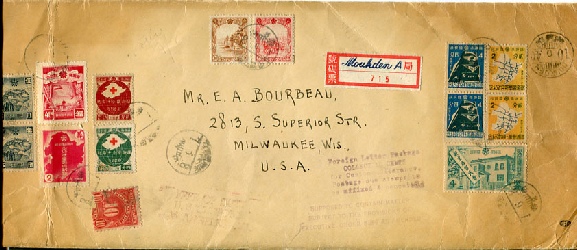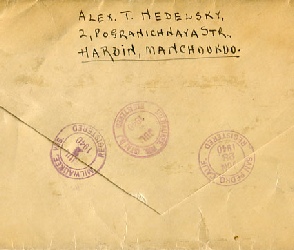
Cliquez sur les images pour agrandir -

LETTRE
Enveloppe imposante de par ses dimensions et son poids, presque 80 g. Mais en lisant la lettre -
Postée le 7 juin au bureau de Harbin Taoli (哈 爾 濱 道 裡 ) l’indication, que ce courrier est recommandé, n’est apposée qu’au bureau de transit de Moukden le 10 juin. De là, la route est ouverte vers Dairen, puis le bateau jusqu’à San Pedro sur la côte ouest des États Unis.
A son arrivée dans les bureaux de la douane, l’enveloppe est examinée. Une première marque est apposée : «Foreign letter Package COLLECT 10 CENTS for customs clearance. Postage due stamps to be affixed & cancelled ».
En clair le courrier est taxé à 10 cts et le timbre idoine est collé et oblitéré. Une seconde marque : « SUPPOSED TO CONTAIN MATTER SUBJECT TO THE PROVISIONS OF EXECUTIVE ORDER 8389 AS AMENDED ». Qui se traduit par : « Supposé contenir des documents soumis aux disposition du décret présidentiel 8389 » indique que le courrier fut examiné par les douanes en application du décret exécutif n°8389.
Ce décret a été émis par le président Franklin D. Roosevelt , le 10 Avril 1940, à la suite des invasions du Danemark et de la Norvège par l'Allemagne. L'une des principales préoccupations du gouvernement américain dans les premières années de la Seconde Guerre mondiale était d'empêcher les nazis d'utiliser les ressources financières des États-
Et enfin une troisième marque : « FREE OF DUTY U.S. CUSTOMS LOS ANGELES » pour indiquer que le document est « Libre de droits » en réponse à la marque précédente.
8 juin 1940 -
–
June 8th, 1940 -
|
Dimensions : |
330 x 130 mm |
|
|
Tarif : |
Lettre internationale, pour 20g…. Surpoids 20 à 80g (3x12 fen)….. Recommandation.……………… Total……………………………… Sur- |
20 fens 36 fens 16 fens 72 fens 2 fens |
|
Période de valeur : |
01/04/1937 au 28/02/1942 |
|
|
Timbres utilisés : |
YT n°74 (paire), 83, 91, 104, 107, 108, 114, 115, 116 et 117 (paires) |
|
|
Oblitération : |
N°41.1 Harbin Taoli - |
|
|
Période d’utilisation : |
24/01/1936 au 22/02/1945 |
|
|
Indications : |
Etiquette « Moukden A 715 » Cachets des douanes américaines (voir commentaire) |
|
|
Transit : |
N°43.1 Moukden - San Pedro. Calif. 28/06/1940 |
|
|
Arrivée : |
Milwaukee.Wis. 2/07/1940 |
|
|
Size : |
330 x 130 mm |
|
|
Rate : |
Foreign letter, for 20g………….. Overweith 20 to 80g (3x12 fen).. Registration fee………………… Total…………………………….. Overpaid……………………….. |
20 fen 36 fen 16 fen 72 fen 2 fen |
|
Period of rate : |
04/01/1937 to 02/28/1942 |
|
|
Stamps : |
SG N°67 (pair), 86, 96, 113, 116, 117, 123, 124, 125 and 126 (pairs) |
|
|
Postmark : |
N°41.1 Harbin Taoli - |
|
|
Period of use : |
01/24/1936 to 02/22/1945 |
|
|
Instructions : |
Registration label « Moukden A 715 » ; Handstamps of US Customhouses (see note) |
|
|
Transit : |
N°43.1 Moukden - San Pedro. Calif. 06/28/1940 |
|
|
Arrival : |
Milwaukee.Wis. 07/02/1940 |
|


An imposing envelope in terms of its size and weight, almost 80g. But reading the letter -
Posted on June 7th at the Harbin Taoli office (哈 爾 濱 道 裡 ) the indication, that this mail is registered, is only affixed at the Moukden transit office on June 10th. From there, the route is open to Dairen, then the boat to San Pedro on the west coast of the United States.
On arrival at the customs office, the envelope is examined. An initial mark is affixed: "Foreign letter Package COLLECT 10 CENTS for customs clearance. Postage due stamps to be affixed & cancelled".
In other words, the mail is taxed at 10 cts and the appropriate stamp is affixed and cancelled. A second mark: "SUPPOSED TO CONTAIN MATTER SUBJECT TO THE PROVISIONS OF EXECUTIVE ORDER 8389 AS AMENDED" indicates that the mail was examined by customs under Executive Order 8389.
This decree was issued by President Franklin D. Roosevelt on April 10th, 1940, following the German invasions of Denmark and Norway. One of the main concerns of the American government in the early years of the Second World War was to prevent the Nazis from using the financial resources of the United States to finance their military campaigns and occupation costs. The task of enforcing this objective by controlling financial assets fell to the Treasury Department, and President Roosevelt enabled these actions by issuing Executive Order 8389, which froze Norwegian and Danish assets in the United States.
And finally a third mark: "FREE OF DUTY U.S. CUSTOMS LOS ANGELES" to indicate that the document is "Libre de droits" in response to the previous mark.